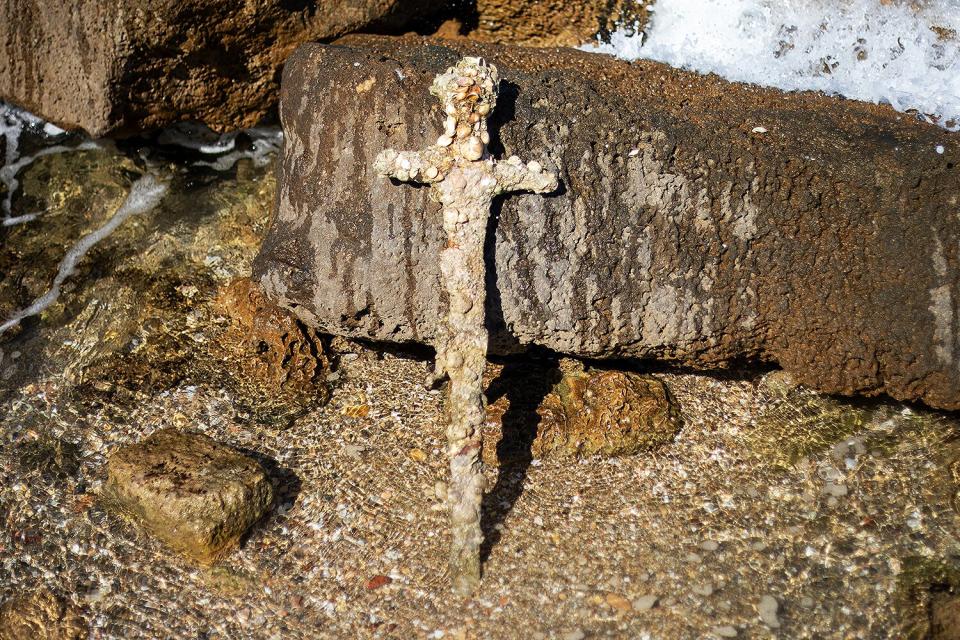Diver Discovers 900-Year-Old Crusader Sword Off Coast of Israel: 'A Beautiful and Rare Find'

A piece of history was found by a diver in Israel — and experts believe the "beautiful and rare" artifact is approximately 900 years old.
The remarkable discovery was made on Saturday, off the Carmel coast in Northern Israel, according to a press release from the Israel Antiquities Authority (IAA).
The IAA said Atlit resident Shlomi Katzin was diving in the Mediterranean Sea when he came across several ancient artifacts on the seabed.
Among the items Katzin found was a sword with a 3.3-foot-long blade and a hilt measuring over 11 inches long, per the release.
Wanting to prevent the sword from being stolen or buried, Katzin took it ashore, where he contacted the inspector for the IAA Northern District's Robbery Prevention Unit to report his findings, the IAA said.
It was later determined by Nir Distelfeld, the inspector, that the sword was a piece of Crusader knight history, dating back to 900 years ago.
RELATED: Extinct Fish Species That Existed Over 420 Million Years Ago Found Alive in the Indian Ocean
The Crusades began in 1095 and consisted of a series of religious wars involving the Christians and Muslims, according to History.com. The wars lasted for centuries as the European Christians traveled to the Middle East and attempted to seize control of Jerusalem and other parts of the Holy Land from the Muslims.

Ariel Schalit/AP/Shutterstock The crusader sword
"The sword, which has been preserved in perfect condition, is a beautiful and rare find and evidently belonged to a Crusader knight," Distelfeld said in a statement. "It was found encrusted with marine organisms, but is apparently made of iron."
"It is exciting to encounter such a personal object, taking you 900 years back in time to a different era, with knights, armor and swords," Distelfeld added.
The sword was found in an area of natural coves, which Kobi Sharvit, the director of the IAA's Marine Archaeology Unit, said "provided shelter for ancient ships in a storm." There, "entire settlements and ancient port cities developed," Sharvit added.
RELATED VIDEO: Debris Spotted In Indian Ocean Could Be MH370
Because it is so rich in historical artifacts, which typically appear and disappear with the movement of the sands, the area has been monitored by the IAA since June, per the release.
"These conditions have attracted merchant ships down the ages, leaving behind rich archaeological finds. The recently recovered sword is just one such find," Sharvit said, noting that it is believed the "natural cove was also used in the Crusader period, some 900 years ago."
Speaking to the New York Times, Sharvit added that the sword was likely preserved for so long due to the warm temperatures of the Mediterranean, and those marine organisms stuck onto the artifact "like glue" while the iron oxidized.
RELATED: Diver Finds Long-Lost iPhone in River with Texts from Woman's Late Dad — and It Still Works!
After handing over the sword to the National Treasures Department, Katzin was given a certificate of appreciation for good citizenship, per the release.
Eli Escosido, the IAA's general director, praised him for bringing the item forward, writing in a statement, "Every ancient artifact that is found helps us piece together the historical puzzle of the Land of Israel."
According to The Washington Post, Israeli law requires people who come across artifacts to return the items to the nation. Officials are now urging others who find similar finds in the sea to report them so they can document the pieces and "retrieve as much archaeological data as possible."
The sword is expected to be cleaned and researched in the IAA's laboratories before it gets displayed to the public.

